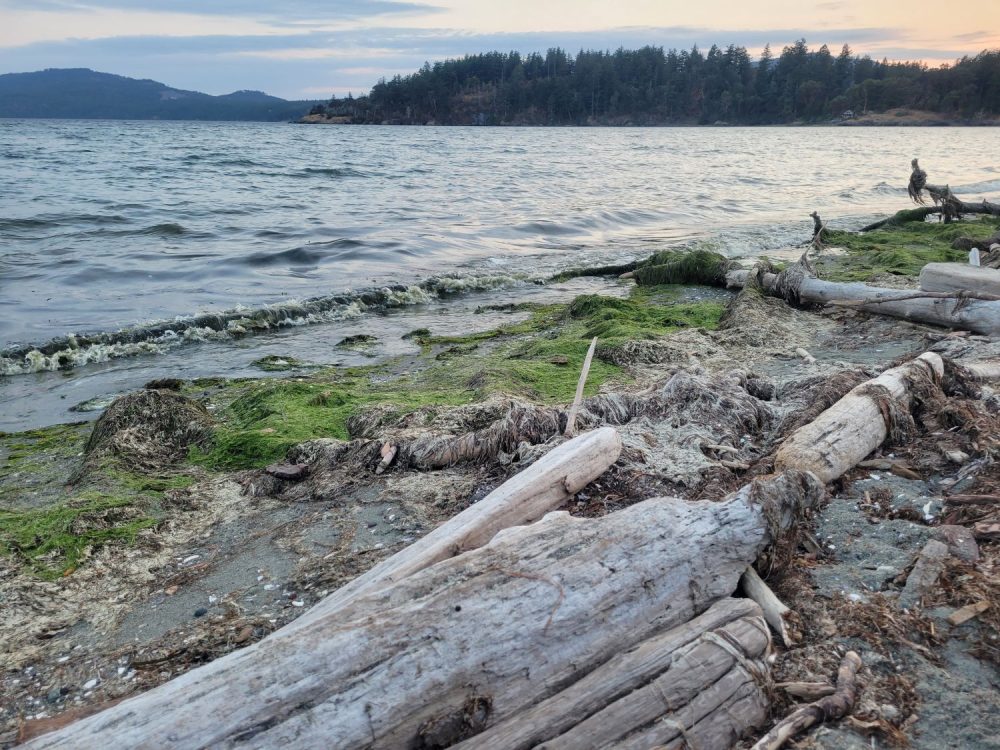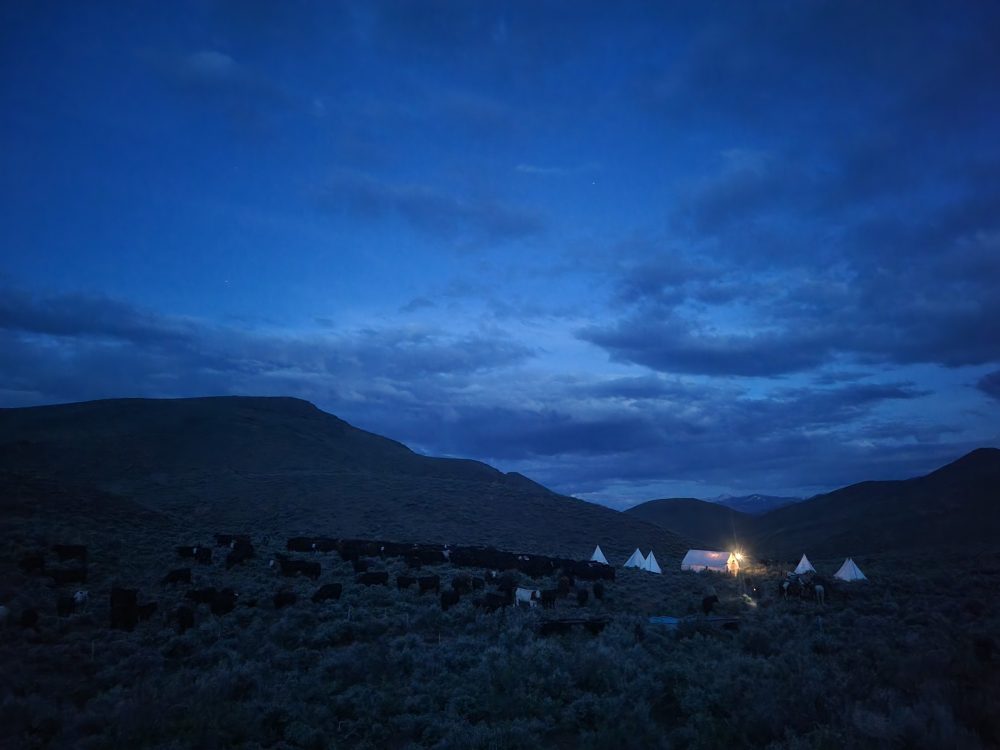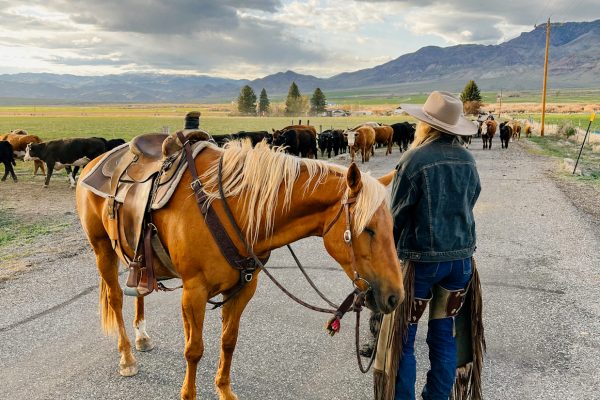Ol’ Snake Bite has come up missing on this, the 4th of July. The little steer, still on the mend from a near-fatal strike from the western diamondback rattler he encountered in the low country, was a little trail weary from the 7 mile hike up to the cool meadows of the high country. Every patch of shade beckoned to him to lie down and rest.

I was bringing up the drag, or rear of the herd of cattle, and the beeves were settling down for a midday break. One by one, the cattle laid down to contentedly chew cud from the abundant grasses they voraciously consumed all morning. Snake Bite did the same, and somehow managed to nestle himself away under a dense pine tree so we didn’t spot him when the herd started moving again, and as a result, he got left behind. It wasn’t until a mile or so later that noticed something was up.
I was taking little groups of the herd down to the portable 750 gallon water tank crew boss Anthony and I put in a few days ago. It channeled a pipe full of water from a lush spring to the tank on a sage brush flat. We had been completely protecting this spring by piping a small portion of its life-giving water to a tank that we will remove at the end of the grazing season. The spring we protect with portable hot wire. When we leave, the only sign that cattle had watered here will be a small trampled area around the tank, which will be indiscernible by the next year. For over a century prior, the spring had been over-grazed by unmanaged cattle use. The beaver had left the drainage, and muddy and warmed water, unshaded and unfiltered because of lack of vegetation, had previously coursed downhill to native Dolly Varden (or bull) trout habitat.
We hadn’t grazed it for 6 years, and planned to keep it that way. Aspen trees were recolonizing the site to the point that they were hard to walk through. It was an island of bright green and diverse structure in the sage brush sea. The birdsong in the aspen forest was continuous with the sound of mating and nesting pairs. The spring itself was a tangle of native plants and shrubs that was chest high, and formidable for two men with armed with a pipe to borrow some water (our bodies were both afire after paying the toll for entry into the wet thickets—the stinging nettle so burned our forearms that I had trouble sleeping that night). Our temporary watering situation was a win-win despite our bruised and brambled bodies: our beeves had access to unlimited clean, cold and un-muddied water, and the habitat could continue to regenerate by leaps and bounds.

I almost could believe that the birds were singing in gratitude, and if you’ve heard ever the ethereal and soulful song of the wood thrush or veery as the sun is setting over the expansive country of the range, I think you’d have to agree. It’s part of what we do that gets me up in the morning.
Anyway, Snake Bite didn’t show up for water. Melanie and Sarah rode horseback through the entire herd trying to locate him, but it was to no avail. I rode our back trail, and came up empty. We could only hope that he would rejoin later before the wolves found him. I would search again before dark, even though horse and rider would be tired.
It’s what Independence Day looks like for us. Now, I’ve moved up from the springs and water tank, and I’m here with tablet over saddle horn, writing my weekly missive. I’m astride Gatto, the gray registered Quarter Horse gelding. His name is taken from his registered name: Solitary Aztec Cat. For sure, he moves a little catlike as we negotiate the rolling hills of the high Little Hat country, but his cool moves are less attributable to his notable bloodlines than the quiet hand of my daughter, Melanie, who trained him. As I turn to check the low part on the ridge we are grazing, he moves off my leg cue nicely. The reins hang slack. I think, without too much trouble, I could ride bridle-less with him. The best horses and horsemen in the long history of horse and man together accomplished the same. He’s sensitized to the balance and feel of my body. I take no credit: it’s what Melanie likes in a horse.
We are on the high crest of a wave on the Sagebrush Ocean, where the ubiquitous gray-green brush of the Intermountain West yields to thick Douglas-fir forest due to the retention and receipt of moisture that occurs at higher elevations. We had just emerged from some of the dark forest with the entire herd; it was a training foray for the crew I rode with today on how to manage nearly 300 teenagers in timber.

The cool shade on this forested foray was invigorating for both human and beast; the yearling beeves picked up the pace as everywhere they saw vibrant green grass in the under story. I can’t say that it was hot outside the forest. Today the mercury only peaks in the low eighties. We are pushing 7000 feet in elevation and the temps are consistently 10 degrees cooler than back home on the ranch. But in the forest, it was still in the high 60’s.
The beeves moved quickly, sometimes trotting with glee through the emerald forest.
It’s almost the psychological and emotional undoing of my crew. I had with me Melanie, crew boss, and Ben, recent Range Science grad from the U of Idaho, and Sarah, Range Science student from University of Nevada. Ben and Sarah have never seen behavior like this before; up until now, the beeves have grazed in the wide open spaces of grass/sagebrush that characterizes the low country of the range.
In the open, they could see all the cattle, all the time. Now, at any given time, you could only see at most a third of the herd in the thick trees. And they were moving with abandon. The crew knew the expanse of the timber that went on beyond our entry point; if they lost some cattle here, they could be searching for lost cattle like Snake Bite for days, and lone beeves in unfamiliar country were easy targets for a foraging wolf pack.
It was good practice. We have a system that works for handling large herds in thick forest. The team embraced the idea and was able to work on it in a real life situation. It was another tool in their herding tool box that they would need to call on often for the rest of the summer.
Now, back in the sage on the windswept ridge, all was quiet. And that’s the range rider’s life: there are long moments of quiet beauty, watching the herd pick their way across the mountain smorgasbord, moments interrupted by sheer panic of randomly spreading recalcitrant bovine teenagers on their exploration of the world. It was a little like releasing a 5 busloads of highschoolers in midtown Manhattan. But now, back in their usual environs of sage grasslands, they settled down.
Two big Angus steers graze within several feet of Gatto and me. I watch the closest one. He takes a bite of bluebunch here, native buckwheat there. Then he wrapped his tongue around the entire bluebonnet-like lupine and ate it from its base. Then he tried a bite of milk vetch seedpods. And then, he headed to another grass- Idaho Fescue. And so it goes, through the entire day. It’s not grass fed beef exactly. It is wild plant beef, and the incredible flavor and nutritional diversity that goes along with it.
It shows up on their coats. They glisten in the sun. All of those natural essential oils and nutrients make for incredible cattle wellness. Even the flies are repelled; on any given animal I may see one or two. On animals on farmed grass fed pasture there are commonly hundreds, if not thousands. I’ve seen it. I’ve been there.
The wild plants and animal wellness are the essence of why we are here. This one thing, the grazing of wild plants, is the objective that brings a whole wagon load of attributes along with it. It gathers together habitat regeneration, horsemanship, stockmanship, teamwork, avian habitat integrity, and directed and intentional grazing, to mention a few.

I’m back off the range now on this July 5th; I had to come off the range early to manage some beef items at the freezer, where all of Alderspring’s inventory is stored. I met Melanie and crew when they returned off their stint late last night.
“We got Ol’ Snake Bite, Dad.” She was beaming.
I let out a sigh of relief. I had been thinking about him all day. “Where was he?”
“Oh—he was just waiting for us on the trail to cow camp the next morning.” She smiled. “I think he was just wondering where everyone went. I had Linnaea on the next crew make sure he got to water.”
So the wolves won’t get him. And he’ll continue on the road to recovery. It’s a long rehab period to get through snakebite. We won’t be able to sell him as our handcrafted beef. We find that animals who suffered any sort of trauma never make great beef, especially from a tenderness standpoint.
 Â But we’ll keep him on the range and ranch until he’s ready, and he gets completely well again. Besides, I’d rather have a steak from him than a commodity beef any day of the week. He may be a tad chewy, but at least he’d be clean.
 But we’ll keep him on the range and ranch until he’s ready, and he gets completely well again. Besides, I’d rather have a steak from him than a commodity beef any day of the week. He may be a tad chewy, but at least he’d be clean.
They are all clean, and incredibly robust. It’s beautiful. I wish you could be there on the range with us. But as it is, you’ll have to enjoy it firsthand in another way: on your plate. It’s worth the work to handcraft it, and it’s worth telling the story of how we do it, because you need to know.
Happy Trails.
Glenn, Caryl, Cowhands and Girls at Alderspring







Leave a Reply